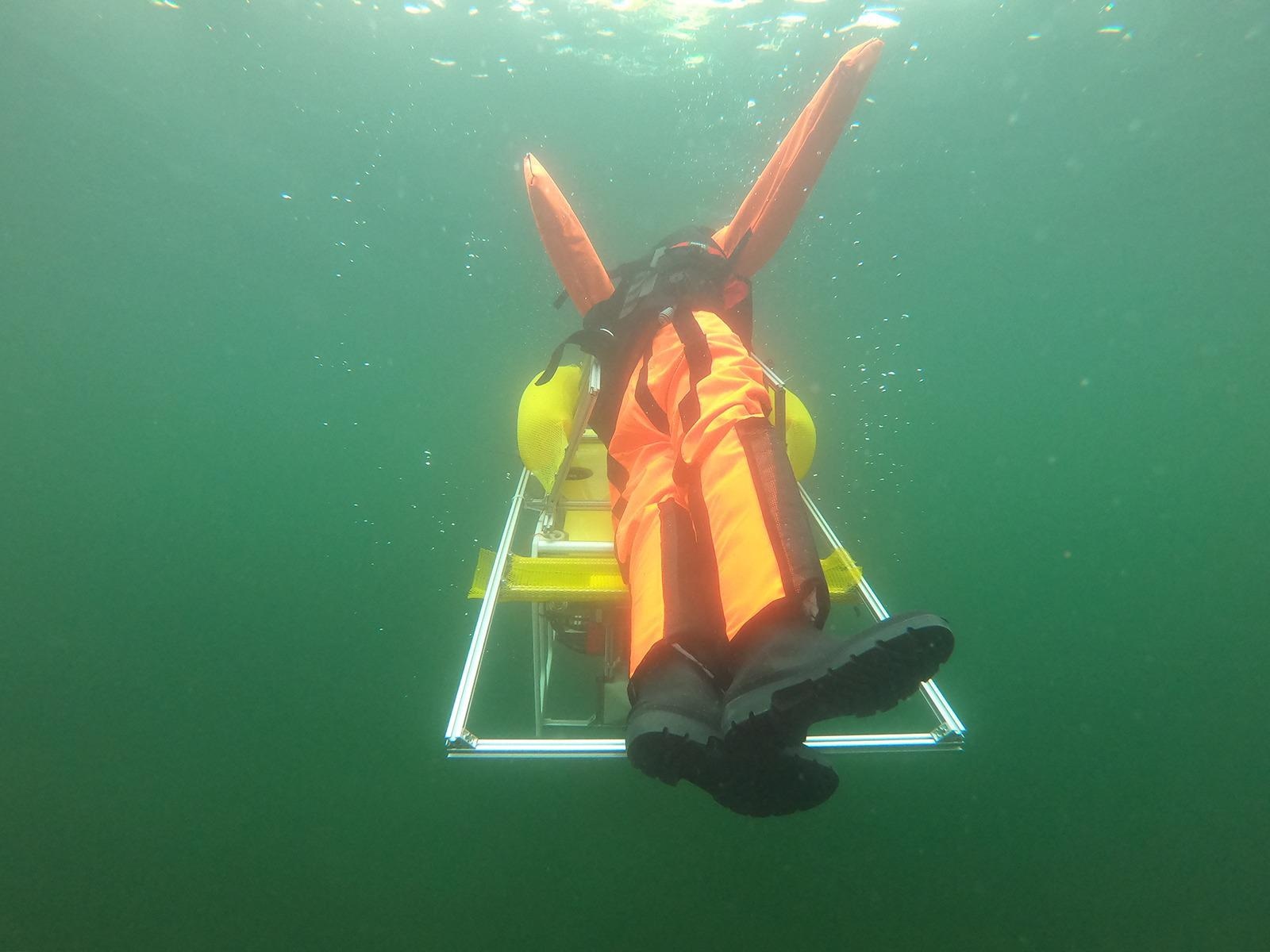Mar 2 2021
The majority of swimming pools in Germany lack sufficient trained lifeguards, and the shortage of this skilled labor is also leading to closures in a number of places.
 During testing at the Hufeisensee lake, the dummy did not slip out of the securing mechanism as it was taken to the surface. Image Credit: © S.Thomas (Wasserwacht Halle).
During testing at the Hufeisensee lake, the dummy did not slip out of the securing mechanism as it was taken to the surface. Image Credit: © S.Thomas (Wasserwacht Halle).
One solution to overcome this problem could be a floating underwater rescue robot, which is meant to assist rescue teams during emergency situations, in the days to come.
Now, a team of researchers from the Fraunhofer Institute for Optronics, System Technologies and Image Exploitation IOSB in Ilmenau has designed an underwater vehicle using Halle’s water rescue service, Wasserrettungsdienstes Halle e.V.
According to the Deutsche Lebens-Rettungsgesellschaft (DLRG)—the German life-saving association—almost 420 persons drowned in 2019 in Germany and many of them had died in freshwater lakes. But serious accidents also took place in swimming pools.
One of the reasons for these accidents is the dearth of trained lifeguards across the country to watch over the swimming pools. A research team from the Institute for Advanced Systems Technology (AST) of Fraunhofer IOSB has now planned to enhance this situation by designing a novel aquatic robot—the first-of-its-kind in the world.
This aquatic robot will support lifesavers and lifeguards and rescue swimmers during emergency situations.
The researchers have used their years of know-how in the field of underwater robotics to design this latest autonomous system. Before this innovation, the team has already developed an autonomous underwater vehicle, called DEDAVE, that received several awards.
There are typical postures that you can use to recognize when someone is in danger.
Helge Renkewitz, Computer Scientist, Fraunhofer Institute for Optronics
Renkewitz headed the already completed study in association with Wasserrettungsdienst Halle e.V. The study was financially supported by the German Federal Ministry for Economic Affairs and Energy (BMWi).
Surveillance cameras fitted on the ceiling of a swimming pool record the position and movement patterns of the drowning individual in the pool, and transmit the coordinates to the autonomous robot.
The data is securely stored away from inquisitive eyes in a docking station located on the floor of the swimming pool, which opens during an emergency.
After reaching its destination, the vehicle finds the endangered persons and carries them to the surface of the pool. A mechanism to keep the rescued person in place prevents unconscious bodies from sliding down as they surface in the pool. Such a mechanism can also be installed on other similar underwater vehicles.
Successful Open-Water Testing
Drones and zeppelin systems perform the job of the surveillance cameras at swimming lakes.
These drones and advertising balloons can easily be fitted with cameras.
Helge Renkewitz, Computer Scientist, Fraunhofer Institute for Optronics
To perform rescue operations in swimming lakes where there is limited visibility, the underwater vehicle should be fitted with acoustic sensors rather than optical ones.
The echoes of sound waves can be used to find out the orientation and positions of persons so accurately that the robot can autonomously move toward the target people and pick them up.
This approach has been demonstrated to work in reality, through the highly remarkable open-water testing performed by scientists at the Hufeisensee lake in Halle (Saale).
A dummy weighing 80 kg was deposited at a depth of 3 m.
The robot picked up this dummy, fixed it in place, brought it to the surface of the pool within a second, and finally carried it through the shortest route—a distance of 40 m—to shore, where the rescue staff was already waiting. As soon as the robot is informed about an emergency, a signal will instantly alert the rescue team.
The full rescue operation lasted just over two minutes. Casualties must be resuscitated within five minutes to avoid long-term damages of the brain. We were able to stay within this critical time frame without any problems.
Helge Renkewitz, Computer Scientist, Fraunhofer Institute for Optronics
The Future Outlook
The current system, fitted with cameras, motor, batteries, and navigational and optical sensors, measures 90 cm in length, 50 cm in height and 50 cm in width. Renkewitz’s research team is aiming to further decrease the size of the aquatic robot and design different models for use in lakes and swimming pools.
The team is also aiming to make the robot lighter, smaller, and more economical than the existing prototype, which is built on a pre-existing underwater vehicle. On the other hand, the future robot will feature the streamlined design of a manta ray.
The researchers have already filed a patent for the aquatic robot. In modified prototype, the robot can perform more tasks, like inspections offshore and dam walls, or it can be used for tracking the health of fish grown in fish farms.
“Our underwater vehicles have a very broad range of applications. For example, they are also suitable for detecting and verifying archaeological artefacts at the bottom of lakes,” concluded the researchers.